Strategic SAP Implementation for Business Process Optimization
VerifiedAdded on 2020/04/07
|11
|4327
|264
AI Summary
The assignment delves into the strategic implementation of SAP solutions within a business context, emphasizing process optimization and operational efficiency. By integrating SAP systems, businesses can centralize data management, streamline operations across departments, and ensure regulatory compliance. The focus is on utilizing SAP's scalability to support business growth, improving customer service through real-time data access, and enhancing security measures. This comprehensive approach not only aims to reduce costs but also significantly boosts productivity by automating redundant processes. Additionally, the assignment highlights the importance of mobility in accessing centralized databases from any location, thereby empowering sales and marketing teams with accurate inventory information. Through improved reporting capabilities, businesses can respond more effectively to complex data requests, further solidifying SAP's role as a pivotal tool in strategic business planning and execution.
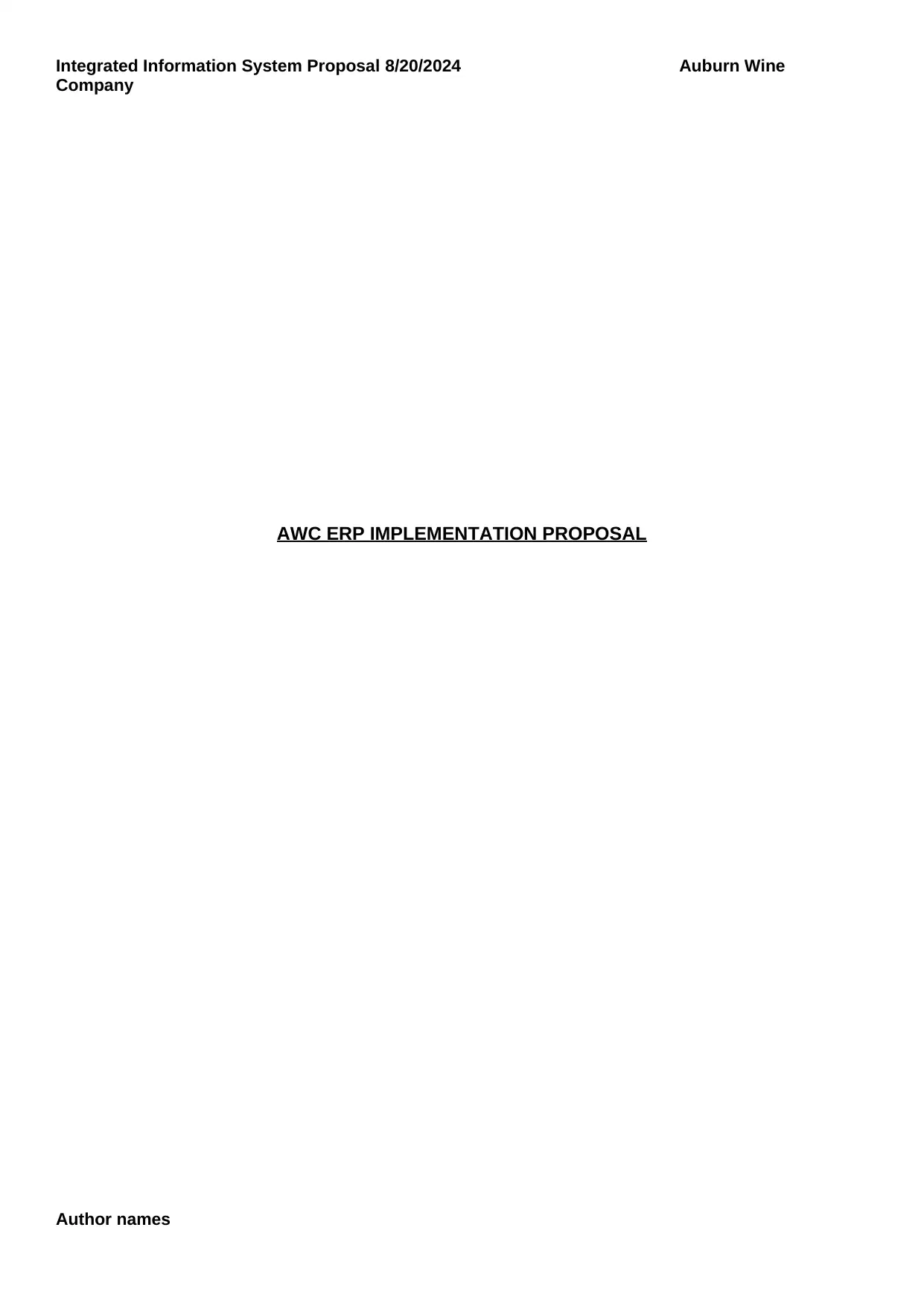
Integrated Information System Proposal 8/20/2024 Auburn Wine
Company
AWC ERP IMPLEMENTATION PROPOSAL
Author names
Company
AWC ERP IMPLEMENTATION PROPOSAL
Author names
Paraphrase This Document
Need a fresh take? Get an instant paraphrase of this document with our AI Paraphraser
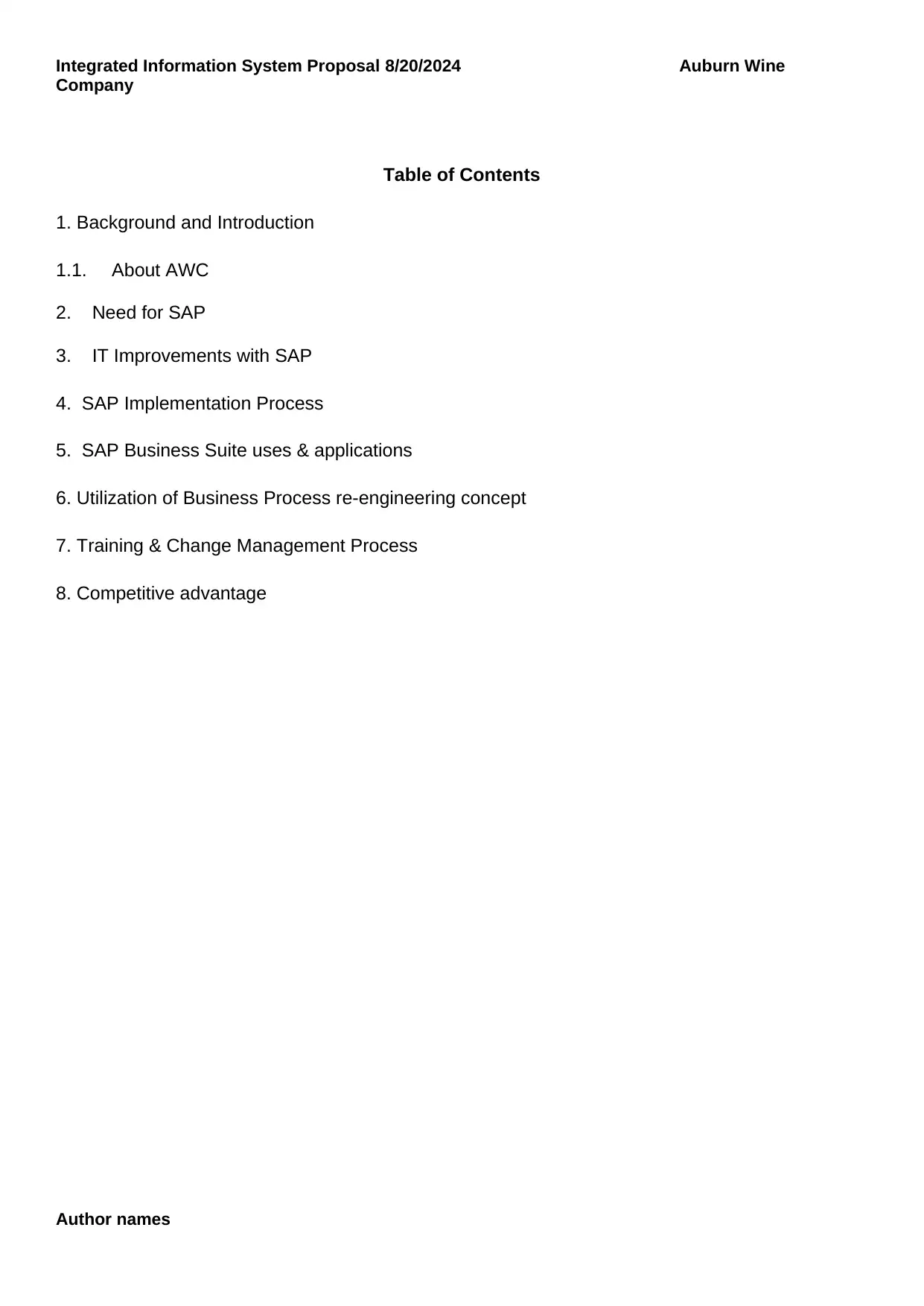
Integrated Information System Proposal 8/20/2024 Auburn Wine
Company
Table of Contents
1. Background and Introduction
1.1. About AWC
2. Need for SAP
3. IT Improvements with SAP
4. SAP Implementation Process
5. SAP Business Suite uses & applications
6. Utilization of Business Process re-engineering concept
7. Training & Change Management Process
8. Competitive advantage
Author names
Company
Table of Contents
1. Background and Introduction
1.1. About AWC
2. Need for SAP
3. IT Improvements with SAP
4. SAP Implementation Process
5. SAP Business Suite uses & applications
6. Utilization of Business Process re-engineering concept
7. Training & Change Management Process
8. Competitive advantage
Author names
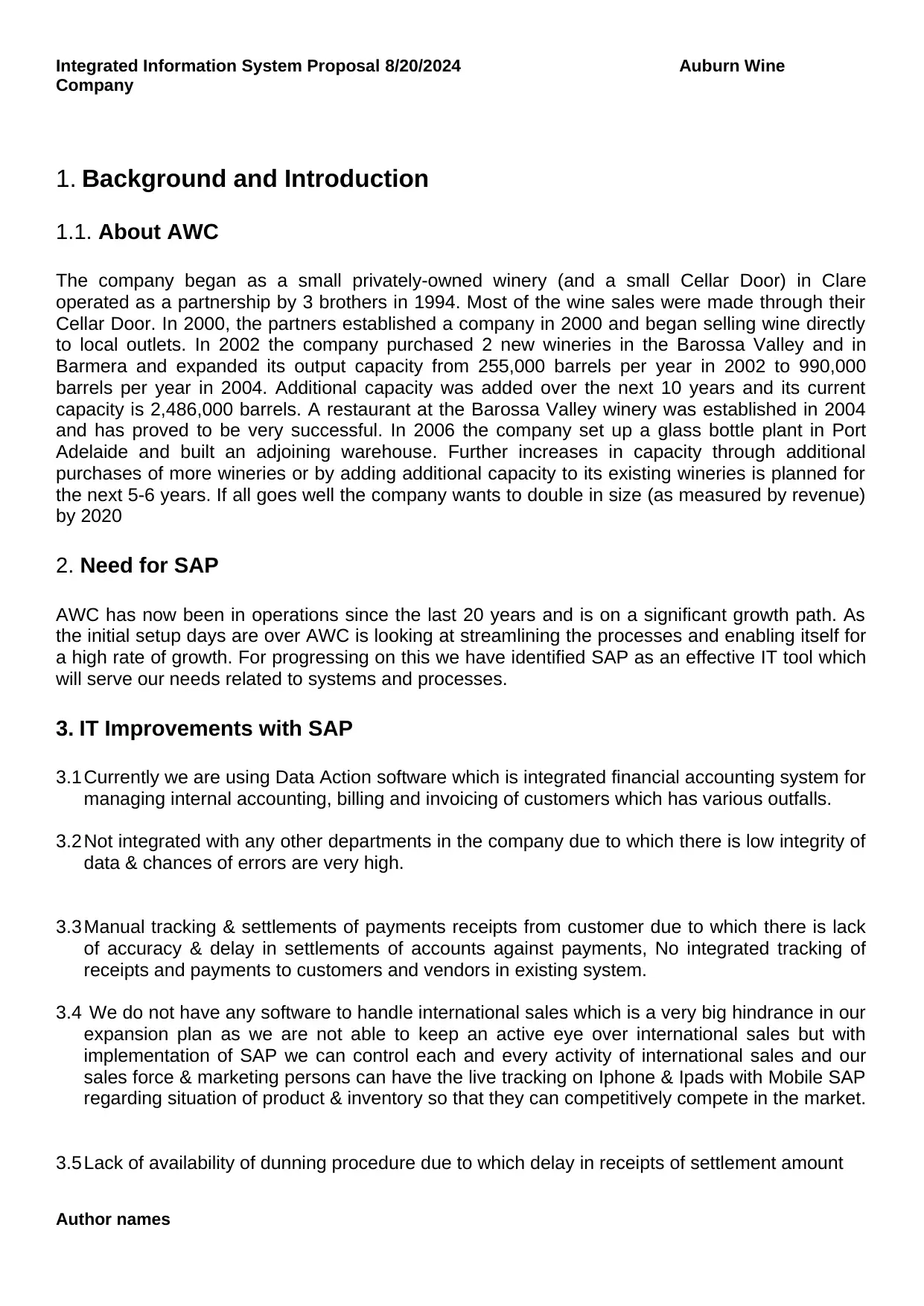
Integrated Information System Proposal 8/20/2024 Auburn Wine
Company
1. Background and Introduction
1.1. About AWC
The company began as a small privately-owned winery (and a small Cellar Door) in Clare
operated as a partnership by 3 brothers in 1994. Most of the wine sales were made through their
Cellar Door. In 2000, the partners established a company in 2000 and began selling wine directly
to local outlets. In 2002 the company purchased 2 new wineries in the Barossa Valley and in
Barmera and expanded its output capacity from 255,000 barrels per year in 2002 to 990,000
barrels per year in 2004. Additional capacity was added over the next 10 years and its current
capacity is 2,486,000 barrels. A restaurant at the Barossa Valley winery was established in 2004
and has proved to be very successful. In 2006 the company set up a glass bottle plant in Port
Adelaide and built an adjoining warehouse. Further increases in capacity through additional
purchases of more wineries or by adding additional capacity to its existing wineries is planned for
the next 5-6 years. If all goes well the company wants to double in size (as measured by revenue)
by 2020
2. Need for SAP
AWC has now been in operations since the last 20 years and is on a significant growth path. As
the initial setup days are over AWC is looking at streamlining the processes and enabling itself for
a high rate of growth. For progressing on this we have identified SAP as an effective IT tool which
will serve our needs related to systems and processes.
3. IT Improvements with SAP
3.1 Currently we are using Data Action software which is integrated financial accounting system for
managing internal accounting, billing and invoicing of customers which has various outfalls.
3.2 Not integrated with any other departments in the company due to which there is low integrity of
data & chances of errors are very high.
3.3 Manual tracking & settlements of payments receipts from customer due to which there is lack
of accuracy & delay in settlements of accounts against payments, No integrated tracking of
receipts and payments to customers and vendors in existing system.
3.4 We do not have any software to handle international sales which is a very big hindrance in our
expansion plan as we are not able to keep an active eye over international sales but with
implementation of SAP we can control each and every activity of international sales and our
sales force & marketing persons can have the live tracking on Iphone & Ipads with Mobile SAP
regarding situation of product & inventory so that they can competitively compete in the market.
3.5 Lack of availability of dunning procedure due to which delay in receipts of settlement amount
Author names
Company
1. Background and Introduction
1.1. About AWC
The company began as a small privately-owned winery (and a small Cellar Door) in Clare
operated as a partnership by 3 brothers in 1994. Most of the wine sales were made through their
Cellar Door. In 2000, the partners established a company in 2000 and began selling wine directly
to local outlets. In 2002 the company purchased 2 new wineries in the Barossa Valley and in
Barmera and expanded its output capacity from 255,000 barrels per year in 2002 to 990,000
barrels per year in 2004. Additional capacity was added over the next 10 years and its current
capacity is 2,486,000 barrels. A restaurant at the Barossa Valley winery was established in 2004
and has proved to be very successful. In 2006 the company set up a glass bottle plant in Port
Adelaide and built an adjoining warehouse. Further increases in capacity through additional
purchases of more wineries or by adding additional capacity to its existing wineries is planned for
the next 5-6 years. If all goes well the company wants to double in size (as measured by revenue)
by 2020
2. Need for SAP
AWC has now been in operations since the last 20 years and is on a significant growth path. As
the initial setup days are over AWC is looking at streamlining the processes and enabling itself for
a high rate of growth. For progressing on this we have identified SAP as an effective IT tool which
will serve our needs related to systems and processes.
3. IT Improvements with SAP
3.1 Currently we are using Data Action software which is integrated financial accounting system for
managing internal accounting, billing and invoicing of customers which has various outfalls.
3.2 Not integrated with any other departments in the company due to which there is low integrity of
data & chances of errors are very high.
3.3 Manual tracking & settlements of payments receipts from customer due to which there is lack
of accuracy & delay in settlements of accounts against payments, No integrated tracking of
receipts and payments to customers and vendors in existing system.
3.4 We do not have any software to handle international sales which is a very big hindrance in our
expansion plan as we are not able to keep an active eye over international sales but with
implementation of SAP we can control each and every activity of international sales and our
sales force & marketing persons can have the live tracking on Iphone & Ipads with Mobile SAP
regarding situation of product & inventory so that they can competitively compete in the market.
3.5 Lack of availability of dunning procedure due to which delay in receipts of settlement amount
Author names
⊘ This is a preview!⊘
Do you want full access?
Subscribe today to unlock all pages.

Trusted by 1+ million students worldwide
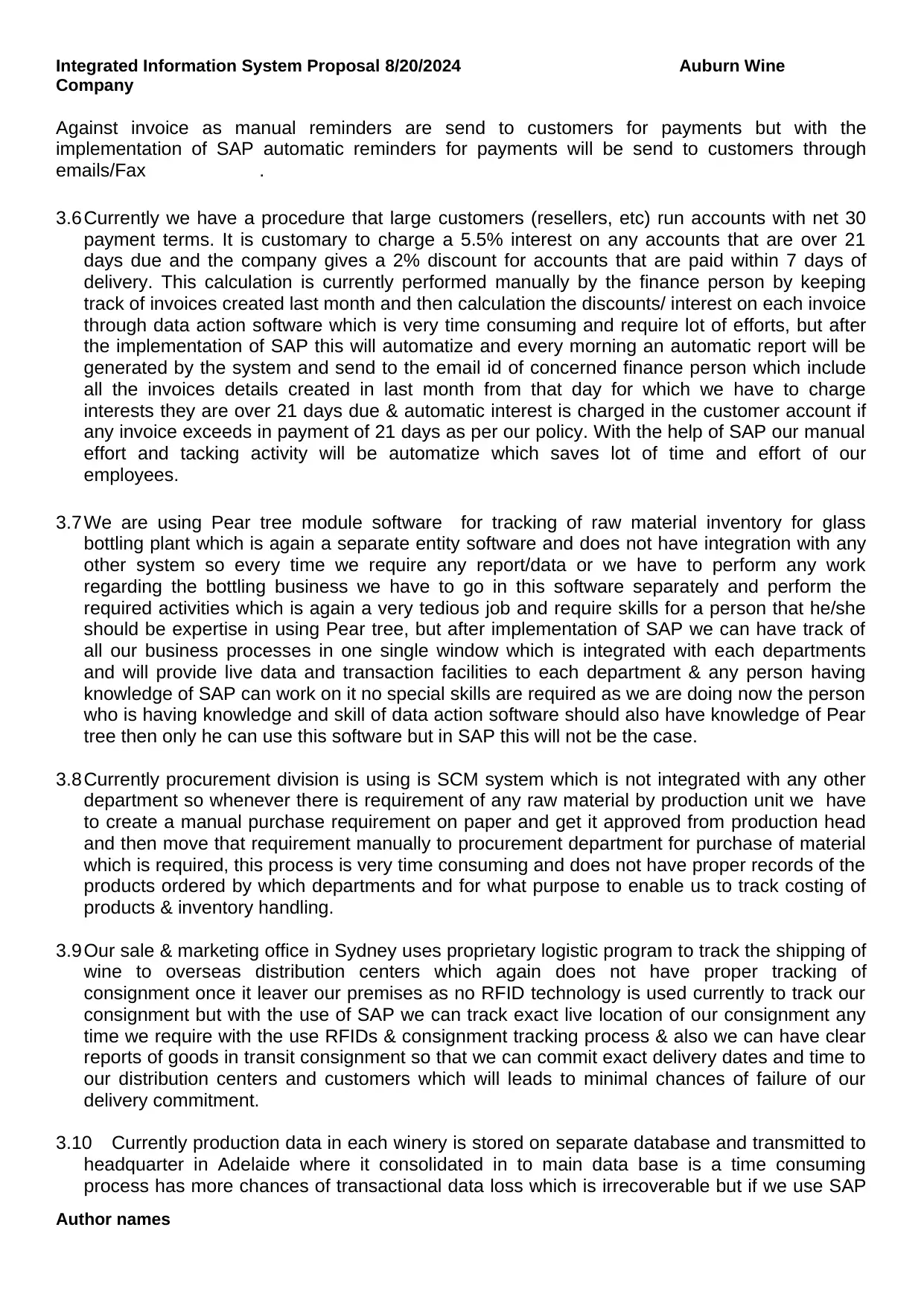
Integrated Information System Proposal 8/20/2024 Auburn Wine
Company
Against invoice as manual reminders are send to customers for payments but with the
implementation of SAP automatic reminders for payments will be send to customers through
emails/Fax .
3.6 Currently we have a procedure that large customers (resellers, etc) run accounts with net 30
payment terms. It is customary to charge a 5.5% interest on any accounts that are over 21
days due and the company gives a 2% discount for accounts that are paid within 7 days of
delivery. This calculation is currently performed manually by the finance person by keeping
track of invoices created last month and then calculation the discounts/ interest on each invoice
through data action software which is very time consuming and require lot of efforts, but after
the implementation of SAP this will automatize and every morning an automatic report will be
generated by the system and send to the email id of concerned finance person which include
all the invoices details created in last month from that day for which we have to charge
interests they are over 21 days due & automatic interest is charged in the customer account if
any invoice exceeds in payment of 21 days as per our policy. With the help of SAP our manual
effort and tacking activity will be automatize which saves lot of time and effort of our
employees.
3.7 We are using Pear tree module software for tracking of raw material inventory for glass
bottling plant which is again a separate entity software and does not have integration with any
other system so every time we require any report/data or we have to perform any work
regarding the bottling business we have to go in this software separately and perform the
required activities which is again a very tedious job and require skills for a person that he/she
should be expertise in using Pear tree, but after implementation of SAP we can have track of
all our business processes in one single window which is integrated with each departments
and will provide live data and transaction facilities to each department & any person having
knowledge of SAP can work on it no special skills are required as we are doing now the person
who is having knowledge and skill of data action software should also have knowledge of Pear
tree then only he can use this software but in SAP this will not be the case.
3.8 Currently procurement division is using is SCM system which is not integrated with any other
department so whenever there is requirement of any raw material by production unit we have
to create a manual purchase requirement on paper and get it approved from production head
and then move that requirement manually to procurement department for purchase of material
which is required, this process is very time consuming and does not have proper records of the
products ordered by which departments and for what purpose to enable us to track costing of
products & inventory handling.
3.9 Our sale & marketing office in Sydney uses proprietary logistic program to track the shipping of
wine to overseas distribution centers which again does not have proper tracking of
consignment once it leaver our premises as no RFID technology is used currently to track our
consignment but with the use of SAP we can track exact live location of our consignment any
time we require with the use RFIDs & consignment tracking process & also we can have clear
reports of goods in transit consignment so that we can commit exact delivery dates and time to
our distribution centers and customers which will leads to minimal chances of failure of our
delivery commitment.
3.10 Currently production data in each winery is stored on separate database and transmitted to
headquarter in Adelaide where it consolidated in to main data base is a time consuming
process has more chances of transactional data loss which is irrecoverable but if we use SAP
Author names
Company
Against invoice as manual reminders are send to customers for payments but with the
implementation of SAP automatic reminders for payments will be send to customers through
emails/Fax .
3.6 Currently we have a procedure that large customers (resellers, etc) run accounts with net 30
payment terms. It is customary to charge a 5.5% interest on any accounts that are over 21
days due and the company gives a 2% discount for accounts that are paid within 7 days of
delivery. This calculation is currently performed manually by the finance person by keeping
track of invoices created last month and then calculation the discounts/ interest on each invoice
through data action software which is very time consuming and require lot of efforts, but after
the implementation of SAP this will automatize and every morning an automatic report will be
generated by the system and send to the email id of concerned finance person which include
all the invoices details created in last month from that day for which we have to charge
interests they are over 21 days due & automatic interest is charged in the customer account if
any invoice exceeds in payment of 21 days as per our policy. With the help of SAP our manual
effort and tacking activity will be automatize which saves lot of time and effort of our
employees.
3.7 We are using Pear tree module software for tracking of raw material inventory for glass
bottling plant which is again a separate entity software and does not have integration with any
other system so every time we require any report/data or we have to perform any work
regarding the bottling business we have to go in this software separately and perform the
required activities which is again a very tedious job and require skills for a person that he/she
should be expertise in using Pear tree, but after implementation of SAP we can have track of
all our business processes in one single window which is integrated with each departments
and will provide live data and transaction facilities to each department & any person having
knowledge of SAP can work on it no special skills are required as we are doing now the person
who is having knowledge and skill of data action software should also have knowledge of Pear
tree then only he can use this software but in SAP this will not be the case.
3.8 Currently procurement division is using is SCM system which is not integrated with any other
department so whenever there is requirement of any raw material by production unit we have
to create a manual purchase requirement on paper and get it approved from production head
and then move that requirement manually to procurement department for purchase of material
which is required, this process is very time consuming and does not have proper records of the
products ordered by which departments and for what purpose to enable us to track costing of
products & inventory handling.
3.9 Our sale & marketing office in Sydney uses proprietary logistic program to track the shipping of
wine to overseas distribution centers which again does not have proper tracking of
consignment once it leaver our premises as no RFID technology is used currently to track our
consignment but with the use of SAP we can track exact live location of our consignment any
time we require with the use RFIDs & consignment tracking process & also we can have clear
reports of goods in transit consignment so that we can commit exact delivery dates and time to
our distribution centers and customers which will leads to minimal chances of failure of our
delivery commitment.
3.10 Currently production data in each winery is stored on separate database and transmitted to
headquarter in Adelaide where it consolidated in to main data base is a time consuming
process has more chances of transactional data loss which is irrecoverable but if we use SAP
Author names
Paraphrase This Document
Need a fresh take? Get an instant paraphrase of this document with our AI Paraphraser
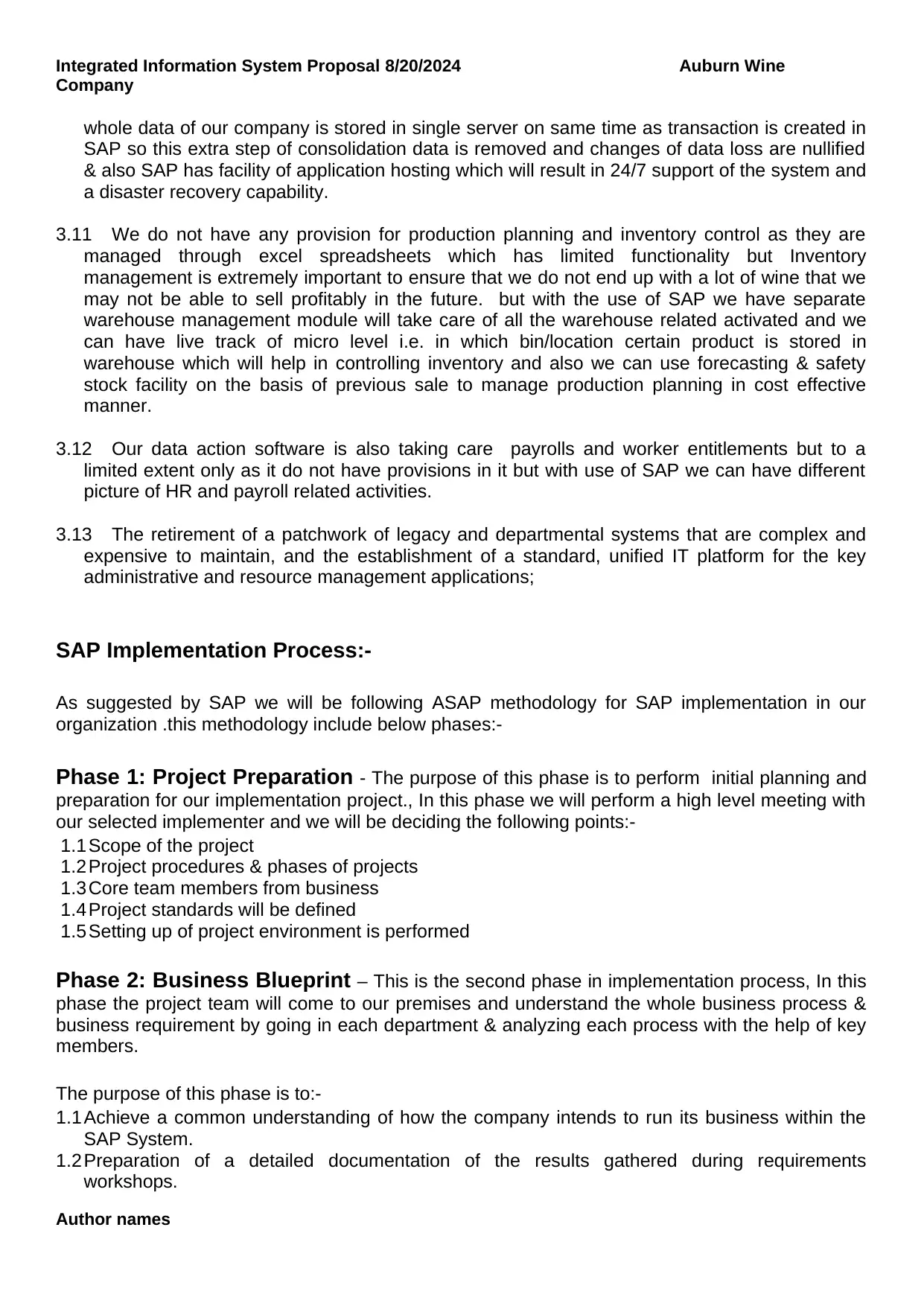
Integrated Information System Proposal 8/20/2024 Auburn Wine
Company
whole data of our company is stored in single server on same time as transaction is created in
SAP so this extra step of consolidation data is removed and changes of data loss are nullified
& also SAP has facility of application hosting which will result in 24/7 support of the system and
a disaster recovery capability.
3.11 We do not have any provision for production planning and inventory control as they are
managed through excel spreadsheets which has limited functionality but Inventory
management is extremely important to ensure that we do not end up with a lot of wine that we
may not be able to sell profitably in the future. but with the use of SAP we have separate
warehouse management module will take care of all the warehouse related activated and we
can have live track of micro level i.e. in which bin/location certain product is stored in
warehouse which will help in controlling inventory and also we can use forecasting & safety
stock facility on the basis of previous sale to manage production planning in cost effective
manner.
3.12 Our data action software is also taking care payrolls and worker entitlements but to a
limited extent only as it do not have provisions in it but with use of SAP we can have different
picture of HR and payroll related activities.
3.13 The retirement of a patchwork of legacy and departmental systems that are complex and
expensive to maintain, and the establishment of a standard, unified IT platform for the key
administrative and resource management applications;
SAP Implementation Process:-
As suggested by SAP we will be following ASAP methodology for SAP implementation in our
organization .this methodology include below phases:-
Phase 1: Project Preparation - The purpose of this phase is to perform initial planning and
preparation for our implementation project., In this phase we will perform a high level meeting with
our selected implementer and we will be deciding the following points:-
1.1 Scope of the project
1.2 Project procedures & phases of projects
1.3 Core team members from business
1.4 Project standards will be defined
1.5 Setting up of project environment is performed
Phase 2: Business Blueprint – This is the second phase in implementation process, In this
phase the project team will come to our premises and understand the whole business process &
business requirement by going in each department & analyzing each process with the help of key
members.
The purpose of this phase is to:-
1.1 Achieve a common understanding of how the company intends to run its business within the
SAP System.
1.2 Preparation of a detailed documentation of the results gathered during requirements
workshops.
Author names
Company
whole data of our company is stored in single server on same time as transaction is created in
SAP so this extra step of consolidation data is removed and changes of data loss are nullified
& also SAP has facility of application hosting which will result in 24/7 support of the system and
a disaster recovery capability.
3.11 We do not have any provision for production planning and inventory control as they are
managed through excel spreadsheets which has limited functionality but Inventory
management is extremely important to ensure that we do not end up with a lot of wine that we
may not be able to sell profitably in the future. but with the use of SAP we have separate
warehouse management module will take care of all the warehouse related activated and we
can have live track of micro level i.e. in which bin/location certain product is stored in
warehouse which will help in controlling inventory and also we can use forecasting & safety
stock facility on the basis of previous sale to manage production planning in cost effective
manner.
3.12 Our data action software is also taking care payrolls and worker entitlements but to a
limited extent only as it do not have provisions in it but with use of SAP we can have different
picture of HR and payroll related activities.
3.13 The retirement of a patchwork of legacy and departmental systems that are complex and
expensive to maintain, and the establishment of a standard, unified IT platform for the key
administrative and resource management applications;
SAP Implementation Process:-
As suggested by SAP we will be following ASAP methodology for SAP implementation in our
organization .this methodology include below phases:-
Phase 1: Project Preparation - The purpose of this phase is to perform initial planning and
preparation for our implementation project., In this phase we will perform a high level meeting with
our selected implementer and we will be deciding the following points:-
1.1 Scope of the project
1.2 Project procedures & phases of projects
1.3 Core team members from business
1.4 Project standards will be defined
1.5 Setting up of project environment is performed
Phase 2: Business Blueprint – This is the second phase in implementation process, In this
phase the project team will come to our premises and understand the whole business process &
business requirement by going in each department & analyzing each process with the help of key
members.
The purpose of this phase is to:-
1.1 Achieve a common understanding of how the company intends to run its business within the
SAP System.
1.2 Preparation of a detailed documentation of the results gathered during requirements
workshops.
Author names
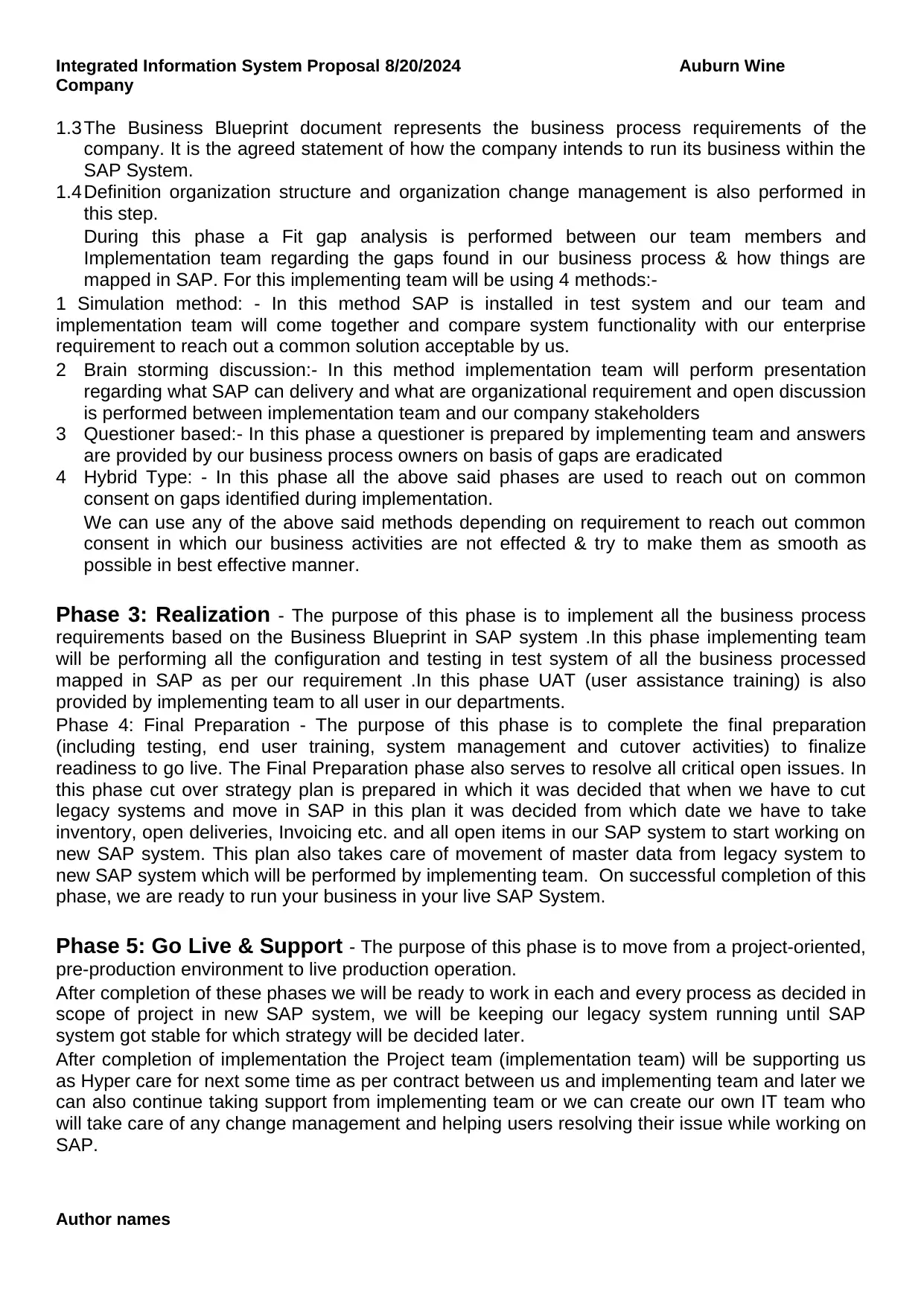
Integrated Information System Proposal 8/20/2024 Auburn Wine
Company
1.3 The Business Blueprint document represents the business process requirements of the
company. It is the agreed statement of how the company intends to run its business within the
SAP System.
1.4 Definition organization structure and organization change management is also performed in
this step.
During this phase a Fit gap analysis is performed between our team members and
Implementation team regarding the gaps found in our business process & how things are
mapped in SAP. For this implementing team will be using 4 methods:-
1 Simulation method: - In this method SAP is installed in test system and our team and
implementation team will come together and compare system functionality with our enterprise
requirement to reach out a common solution acceptable by us.
2 Brain storming discussion:- In this method implementation team will perform presentation
regarding what SAP can delivery and what are organizational requirement and open discussion
is performed between implementation team and our company stakeholders
3 Questioner based:- In this phase a questioner is prepared by implementing team and answers
are provided by our business process owners on basis of gaps are eradicated
4 Hybrid Type: - In this phase all the above said phases are used to reach out on common
consent on gaps identified during implementation.
We can use any of the above said methods depending on requirement to reach out common
consent in which our business activities are not effected & try to make them as smooth as
possible in best effective manner.
Phase 3: Realization - The purpose of this phase is to implement all the business process
requirements based on the Business Blueprint in SAP system .In this phase implementing team
will be performing all the configuration and testing in test system of all the business processed
mapped in SAP as per our requirement .In this phase UAT (user assistance training) is also
provided by implementing team to all user in our departments.
Phase 4: Final Preparation - The purpose of this phase is to complete the final preparation
(including testing, end user training, system management and cutover activities) to finalize
readiness to go live. The Final Preparation phase also serves to resolve all critical open issues. In
this phase cut over strategy plan is prepared in which it was decided that when we have to cut
legacy systems and move in SAP in this plan it was decided from which date we have to take
inventory, open deliveries, Invoicing etc. and all open items in our SAP system to start working on
new SAP system. This plan also takes care of movement of master data from legacy system to
new SAP system which will be performed by implementing team. On successful completion of this
phase, we are ready to run your business in your live SAP System.
Phase 5: Go Live & Support - The purpose of this phase is to move from a project-oriented,
pre-production environment to live production operation.
After completion of these phases we will be ready to work in each and every process as decided in
scope of project in new SAP system, we will be keeping our legacy system running until SAP
system got stable for which strategy will be decided later.
After completion of implementation the Project team (implementation team) will be supporting us
as Hyper care for next some time as per contract between us and implementing team and later we
can also continue taking support from implementing team or we can create our own IT team who
will take care of any change management and helping users resolving their issue while working on
SAP.
Author names
Company
1.3 The Business Blueprint document represents the business process requirements of the
company. It is the agreed statement of how the company intends to run its business within the
SAP System.
1.4 Definition organization structure and organization change management is also performed in
this step.
During this phase a Fit gap analysis is performed between our team members and
Implementation team regarding the gaps found in our business process & how things are
mapped in SAP. For this implementing team will be using 4 methods:-
1 Simulation method: - In this method SAP is installed in test system and our team and
implementation team will come together and compare system functionality with our enterprise
requirement to reach out a common solution acceptable by us.
2 Brain storming discussion:- In this method implementation team will perform presentation
regarding what SAP can delivery and what are organizational requirement and open discussion
is performed between implementation team and our company stakeholders
3 Questioner based:- In this phase a questioner is prepared by implementing team and answers
are provided by our business process owners on basis of gaps are eradicated
4 Hybrid Type: - In this phase all the above said phases are used to reach out on common
consent on gaps identified during implementation.
We can use any of the above said methods depending on requirement to reach out common
consent in which our business activities are not effected & try to make them as smooth as
possible in best effective manner.
Phase 3: Realization - The purpose of this phase is to implement all the business process
requirements based on the Business Blueprint in SAP system .In this phase implementing team
will be performing all the configuration and testing in test system of all the business processed
mapped in SAP as per our requirement .In this phase UAT (user assistance training) is also
provided by implementing team to all user in our departments.
Phase 4: Final Preparation - The purpose of this phase is to complete the final preparation
(including testing, end user training, system management and cutover activities) to finalize
readiness to go live. The Final Preparation phase also serves to resolve all critical open issues. In
this phase cut over strategy plan is prepared in which it was decided that when we have to cut
legacy systems and move in SAP in this plan it was decided from which date we have to take
inventory, open deliveries, Invoicing etc. and all open items in our SAP system to start working on
new SAP system. This plan also takes care of movement of master data from legacy system to
new SAP system which will be performed by implementing team. On successful completion of this
phase, we are ready to run your business in your live SAP System.
Phase 5: Go Live & Support - The purpose of this phase is to move from a project-oriented,
pre-production environment to live production operation.
After completion of these phases we will be ready to work in each and every process as decided in
scope of project in new SAP system, we will be keeping our legacy system running until SAP
system got stable for which strategy will be decided later.
After completion of implementation the Project team (implementation team) will be supporting us
as Hyper care for next some time as per contract between us and implementing team and later we
can also continue taking support from implementing team or we can create our own IT team who
will take care of any change management and helping users resolving their issue while working on
SAP.
Author names
⊘ This is a preview!⊘
Do you want full access?
Subscribe today to unlock all pages.

Trusted by 1+ million students worldwide
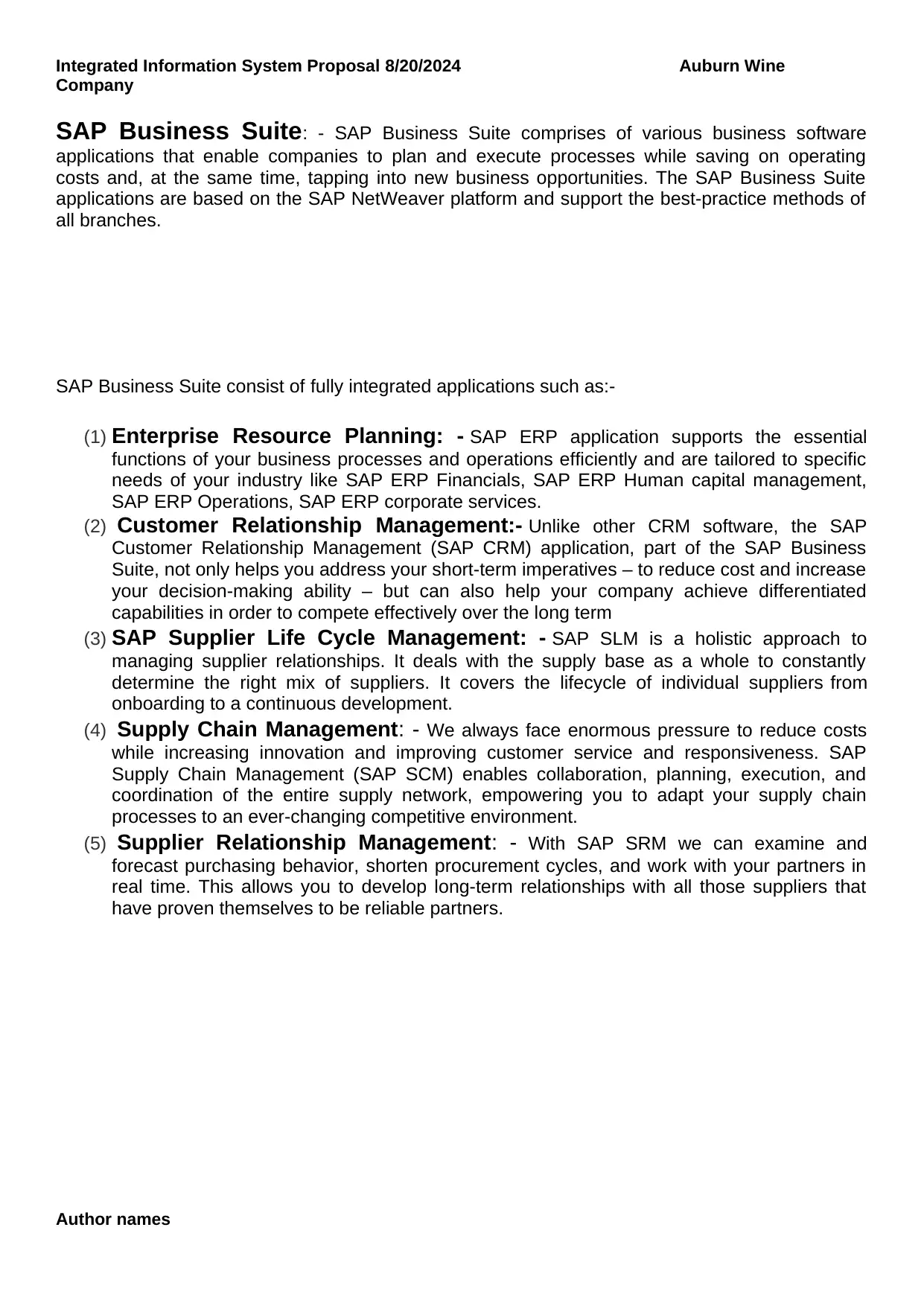
Integrated Information System Proposal 8/20/2024 Auburn Wine
Company
SAP Business Suite: - SAP Business Suite comprises of various business software
applications that enable companies to plan and execute processes while saving on operating
costs and, at the same time, tapping into new business opportunities. The SAP Business Suite
applications are based on the SAP NetWeaver platform and support the best-practice methods of
all branches.
SAP Business Suite consist of fully integrated applications such as:-
(1) Enterprise Resource Planning: - SAP ERP application supports the essential
functions of your business processes and operations efficiently and are tailored to specific
needs of your industry like SAP ERP Financials, SAP ERP Human capital management,
SAP ERP Operations, SAP ERP corporate services.
(2) Customer Relationship Management:- Unlike other CRM software, the SAP
Customer Relationship Management (SAP CRM) application, part of the SAP Business
Suite, not only helps you address your short-term imperatives – to reduce cost and increase
your decision-making ability – but can also help your company achieve differentiated
capabilities in order to compete effectively over the long term
(3) SAP Supplier Life Cycle Management: - SAP SLM is a holistic approach to
managing supplier relationships. It deals with the supply base as a whole to constantly
determine the right mix of suppliers. It covers the lifecycle of individual suppliers from
onboarding to a continuous development.
(4) Supply Chain Management: - We always face enormous pressure to reduce costs
while increasing innovation and improving customer service and responsiveness. SAP
Supply Chain Management (SAP SCM) enables collaboration, planning, execution, and
coordination of the entire supply network, empowering you to adapt your supply chain
processes to an ever-changing competitive environment.
(5) Supplier Relationship Management: - With SAP SRM we can examine and
forecast purchasing behavior, shorten procurement cycles, and work with your partners in
real time. This allows you to develop long-term relationships with all those suppliers that
have proven themselves to be reliable partners.
Author names
Company
SAP Business Suite: - SAP Business Suite comprises of various business software
applications that enable companies to plan and execute processes while saving on operating
costs and, at the same time, tapping into new business opportunities. The SAP Business Suite
applications are based on the SAP NetWeaver platform and support the best-practice methods of
all branches.
SAP Business Suite consist of fully integrated applications such as:-
(1) Enterprise Resource Planning: - SAP ERP application supports the essential
functions of your business processes and operations efficiently and are tailored to specific
needs of your industry like SAP ERP Financials, SAP ERP Human capital management,
SAP ERP Operations, SAP ERP corporate services.
(2) Customer Relationship Management:- Unlike other CRM software, the SAP
Customer Relationship Management (SAP CRM) application, part of the SAP Business
Suite, not only helps you address your short-term imperatives – to reduce cost and increase
your decision-making ability – but can also help your company achieve differentiated
capabilities in order to compete effectively over the long term
(3) SAP Supplier Life Cycle Management: - SAP SLM is a holistic approach to
managing supplier relationships. It deals with the supply base as a whole to constantly
determine the right mix of suppliers. It covers the lifecycle of individual suppliers from
onboarding to a continuous development.
(4) Supply Chain Management: - We always face enormous pressure to reduce costs
while increasing innovation and improving customer service and responsiveness. SAP
Supply Chain Management (SAP SCM) enables collaboration, planning, execution, and
coordination of the entire supply network, empowering you to adapt your supply chain
processes to an ever-changing competitive environment.
(5) Supplier Relationship Management: - With SAP SRM we can examine and
forecast purchasing behavior, shorten procurement cycles, and work with your partners in
real time. This allows you to develop long-term relationships with all those suppliers that
have proven themselves to be reliable partners.
Author names
Paraphrase This Document
Need a fresh take? Get an instant paraphrase of this document with our AI Paraphraser
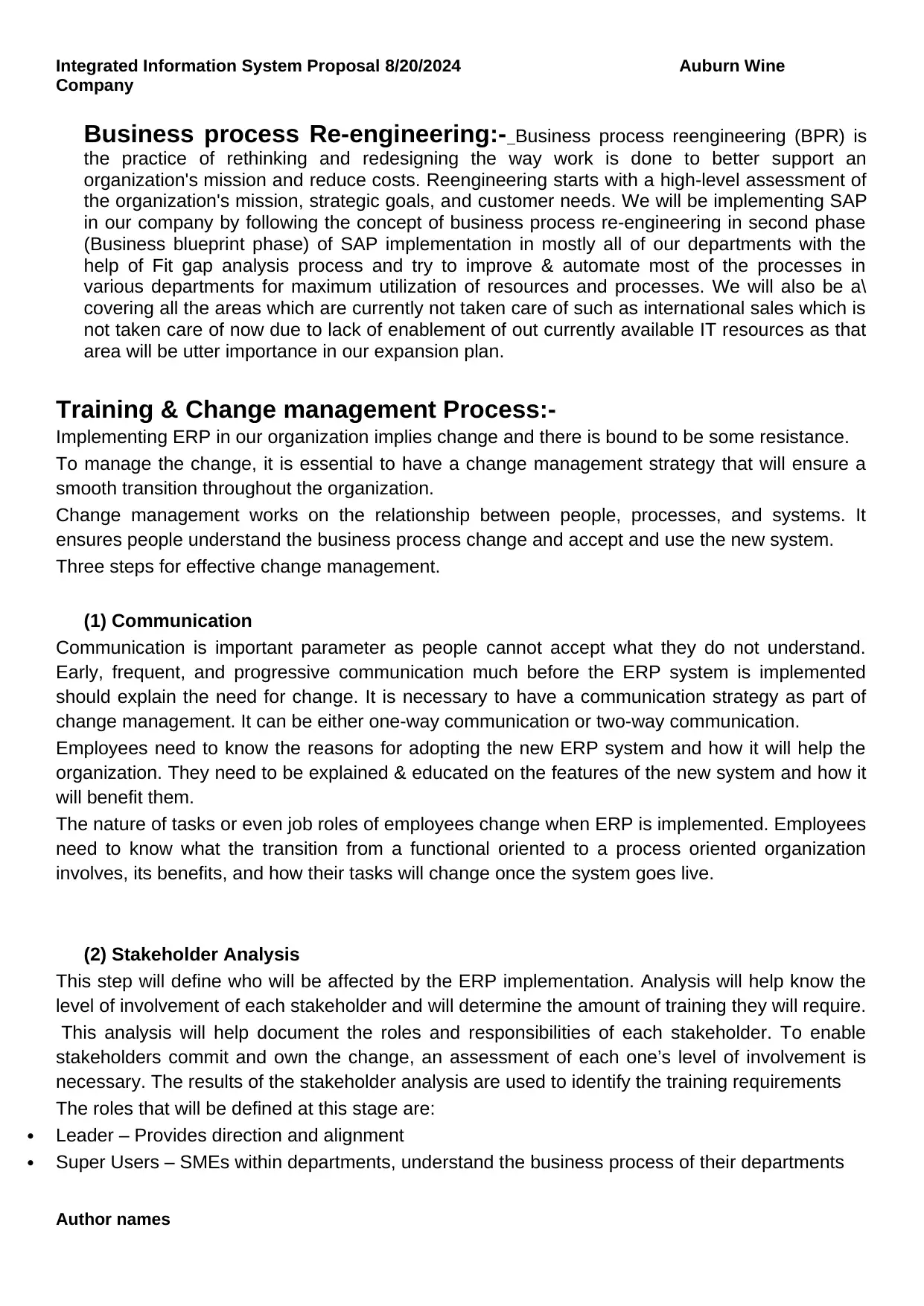
Integrated Information System Proposal 8/20/2024 Auburn Wine
Company
Business process Re-engineering:- Business process reengineering (BPR) is
the practice of rethinking and redesigning the way work is done to better support an
organization's mission and reduce costs. Reengineering starts with a high-level assessment of
the organization's mission, strategic goals, and customer needs. We will be implementing SAP
in our company by following the concept of business process re-engineering in second phase
(Business blueprint phase) of SAP implementation in mostly all of our departments with the
help of Fit gap analysis process and try to improve & automate most of the processes in
various departments for maximum utilization of resources and processes. We will also be a\
covering all the areas which are currently not taken care of such as international sales which is
not taken care of now due to lack of enablement of out currently available IT resources as that
area will be utter importance in our expansion plan.
Training & Change management Process:-
Implementing ERP in our organization implies change and there is bound to be some resistance.
To manage the change, it is essential to have a change management strategy that will ensure a
smooth transition throughout the organization.
Change management works on the relationship between people, processes, and systems. It
ensures people understand the business process change and accept and use the new system.
Three steps for effective change management.
(1) Communication
Communication is important parameter as people cannot accept what they do not understand.
Early, frequent, and progressive communication much before the ERP system is implemented
should explain the need for change. It is necessary to have a communication strategy as part of
change management. It can be either one-way communication or two-way communication.
Employees need to know the reasons for adopting the new ERP system and how it will help the
organization. They need to be explained & educated on the features of the new system and how it
will benefit them.
The nature of tasks or even job roles of employees change when ERP is implemented. Employees
need to know what the transition from a functional oriented to a process oriented organization
involves, its benefits, and how their tasks will change once the system goes live.
(2) Stakeholder Analysis
This step will define who will be affected by the ERP implementation. Analysis will help know the
level of involvement of each stakeholder and will determine the amount of training they will require.
This analysis will help document the roles and responsibilities of each stakeholder. To enable
stakeholders commit and own the change, an assessment of each one’s level of involvement is
necessary. The results of the stakeholder analysis are used to identify the training requirements
The roles that will be defined at this stage are:
Leader – Provides direction and alignment
Super Users – SMEs within departments, understand the business process of their departments
Author names
Company
Business process Re-engineering:- Business process reengineering (BPR) is
the practice of rethinking and redesigning the way work is done to better support an
organization's mission and reduce costs. Reengineering starts with a high-level assessment of
the organization's mission, strategic goals, and customer needs. We will be implementing SAP
in our company by following the concept of business process re-engineering in second phase
(Business blueprint phase) of SAP implementation in mostly all of our departments with the
help of Fit gap analysis process and try to improve & automate most of the processes in
various departments for maximum utilization of resources and processes. We will also be a\
covering all the areas which are currently not taken care of such as international sales which is
not taken care of now due to lack of enablement of out currently available IT resources as that
area will be utter importance in our expansion plan.
Training & Change management Process:-
Implementing ERP in our organization implies change and there is bound to be some resistance.
To manage the change, it is essential to have a change management strategy that will ensure a
smooth transition throughout the organization.
Change management works on the relationship between people, processes, and systems. It
ensures people understand the business process change and accept and use the new system.
Three steps for effective change management.
(1) Communication
Communication is important parameter as people cannot accept what they do not understand.
Early, frequent, and progressive communication much before the ERP system is implemented
should explain the need for change. It is necessary to have a communication strategy as part of
change management. It can be either one-way communication or two-way communication.
Employees need to know the reasons for adopting the new ERP system and how it will help the
organization. They need to be explained & educated on the features of the new system and how it
will benefit them.
The nature of tasks or even job roles of employees change when ERP is implemented. Employees
need to know what the transition from a functional oriented to a process oriented organization
involves, its benefits, and how their tasks will change once the system goes live.
(2) Stakeholder Analysis
This step will define who will be affected by the ERP implementation. Analysis will help know the
level of involvement of each stakeholder and will determine the amount of training they will require.
This analysis will help document the roles and responsibilities of each stakeholder. To enable
stakeholders commit and own the change, an assessment of each one’s level of involvement is
necessary. The results of the stakeholder analysis are used to identify the training requirements
The roles that will be defined at this stage are:
Leader – Provides direction and alignment
Super Users – SMEs within departments, understand the business process of their departments
Author names
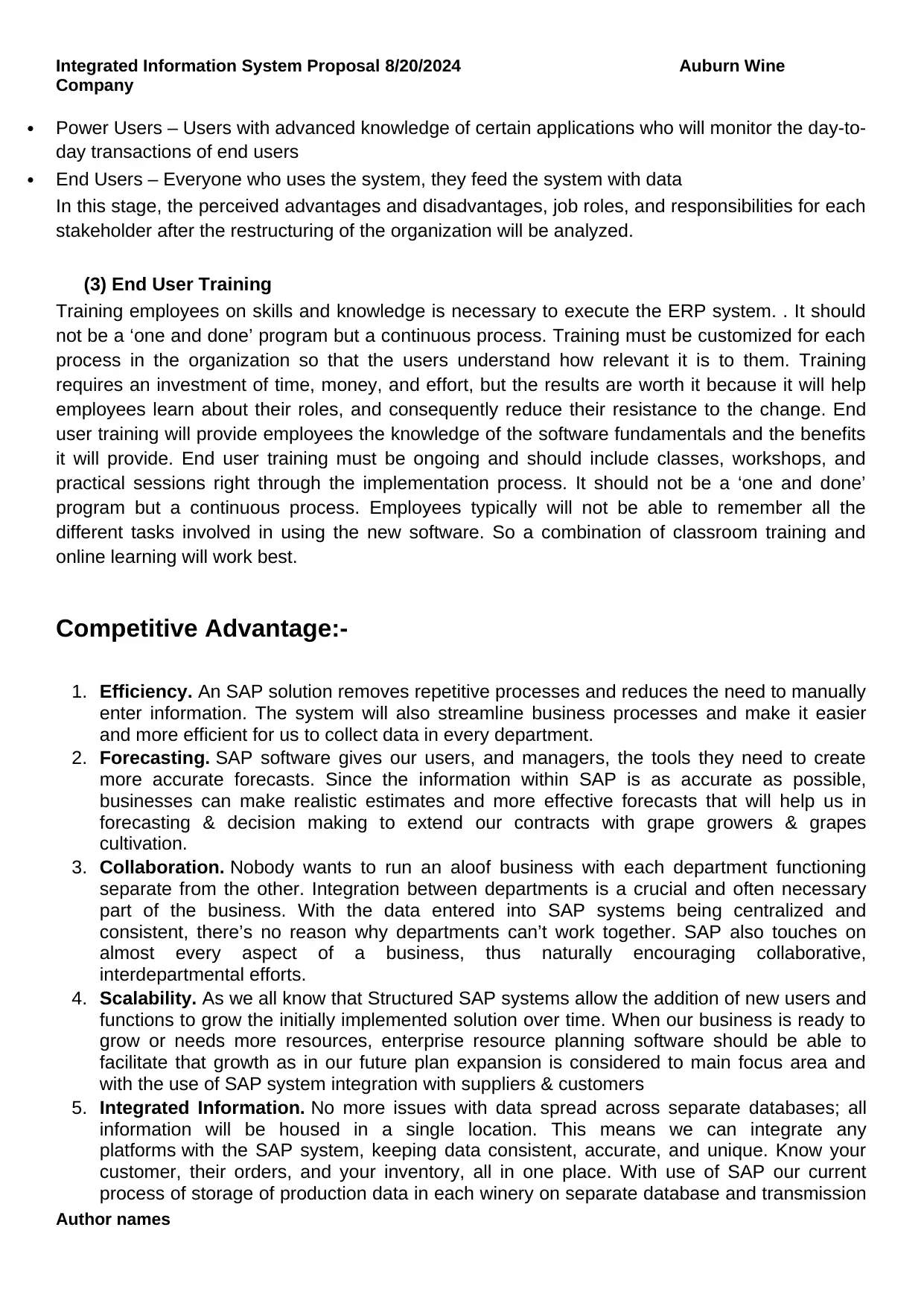
Integrated Information System Proposal 8/20/2024 Auburn Wine
Company
Power Users – Users with advanced knowledge of certain applications who will monitor the day-to-
day transactions of end users
End Users – Everyone who uses the system, they feed the system with data
In this stage, the perceived advantages and disadvantages, job roles, and responsibilities for each
stakeholder after the restructuring of the organization will be analyzed.
(3) End User Training
Training employees on skills and knowledge is necessary to execute the ERP system. . It should
not be a ‘one and done’ program but a continuous process. Training must be customized for each
process in the organization so that the users understand how relevant it is to them. Training
requires an investment of time, money, and effort, but the results are worth it because it will help
employees learn about their roles, and consequently reduce their resistance to the change. End
user training will provide employees the knowledge of the software fundamentals and the benefits
it will provide. End user training must be ongoing and should include classes, workshops, and
practical sessions right through the implementation process. It should not be a ‘one and done’
program but a continuous process. Employees typically will not be able to remember all the
different tasks involved in using the new software. So a combination of classroom training and
online learning will work best.
Competitive Advantage:-
1. Efficiency. An SAP solution removes repetitive processes and reduces the need to manually
enter information. The system will also streamline business processes and make it easier
and more efficient for us to collect data in every department.
2. Forecasting. SAP software gives our users, and managers, the tools they need to create
more accurate forecasts. Since the information within SAP is as accurate as possible,
businesses can make realistic estimates and more effective forecasts that will help us in
forecasting & decision making to extend our contracts with grape growers & grapes
cultivation.
3. Collaboration. Nobody wants to run an aloof business with each department functioning
separate from the other. Integration between departments is a crucial and often necessary
part of the business. With the data entered into SAP systems being centralized and
consistent, there’s no reason why departments can’t work together. SAP also touches on
almost every aspect of a business, thus naturally encouraging collaborative,
interdepartmental efforts.
4. Scalability. As we all know that Structured SAP systems allow the addition of new users and
functions to grow the initially implemented solution over time. When our business is ready to
grow or needs more resources, enterprise resource planning software should be able to
facilitate that growth as in our future plan expansion is considered to main focus area and
with the use of SAP system integration with suppliers & customers
5. Integrated Information. No more issues with data spread across separate databases; all
information will be housed in a single location. This means we can integrate any
platforms with the SAP system, keeping data consistent, accurate, and unique. Know your
customer, their orders, and your inventory, all in one place. With use of SAP our current
process of storage of production data in each winery on separate database and transmission
Author names
Company
Power Users – Users with advanced knowledge of certain applications who will monitor the day-to-
day transactions of end users
End Users – Everyone who uses the system, they feed the system with data
In this stage, the perceived advantages and disadvantages, job roles, and responsibilities for each
stakeholder after the restructuring of the organization will be analyzed.
(3) End User Training
Training employees on skills and knowledge is necessary to execute the ERP system. . It should
not be a ‘one and done’ program but a continuous process. Training must be customized for each
process in the organization so that the users understand how relevant it is to them. Training
requires an investment of time, money, and effort, but the results are worth it because it will help
employees learn about their roles, and consequently reduce their resistance to the change. End
user training will provide employees the knowledge of the software fundamentals and the benefits
it will provide. End user training must be ongoing and should include classes, workshops, and
practical sessions right through the implementation process. It should not be a ‘one and done’
program but a continuous process. Employees typically will not be able to remember all the
different tasks involved in using the new software. So a combination of classroom training and
online learning will work best.
Competitive Advantage:-
1. Efficiency. An SAP solution removes repetitive processes and reduces the need to manually
enter information. The system will also streamline business processes and make it easier
and more efficient for us to collect data in every department.
2. Forecasting. SAP software gives our users, and managers, the tools they need to create
more accurate forecasts. Since the information within SAP is as accurate as possible,
businesses can make realistic estimates and more effective forecasts that will help us in
forecasting & decision making to extend our contracts with grape growers & grapes
cultivation.
3. Collaboration. Nobody wants to run an aloof business with each department functioning
separate from the other. Integration between departments is a crucial and often necessary
part of the business. With the data entered into SAP systems being centralized and
consistent, there’s no reason why departments can’t work together. SAP also touches on
almost every aspect of a business, thus naturally encouraging collaborative,
interdepartmental efforts.
4. Scalability. As we all know that Structured SAP systems allow the addition of new users and
functions to grow the initially implemented solution over time. When our business is ready to
grow or needs more resources, enterprise resource planning software should be able to
facilitate that growth as in our future plan expansion is considered to main focus area and
with the use of SAP system integration with suppliers & customers
5. Integrated Information. No more issues with data spread across separate databases; all
information will be housed in a single location. This means we can integrate any
platforms with the SAP system, keeping data consistent, accurate, and unique. Know your
customer, their orders, and your inventory, all in one place. With use of SAP our current
process of storage of production data in each winery on separate database and transmission
Author names
⊘ This is a preview!⊘
Do you want full access?
Subscribe today to unlock all pages.

Trusted by 1+ million students worldwide
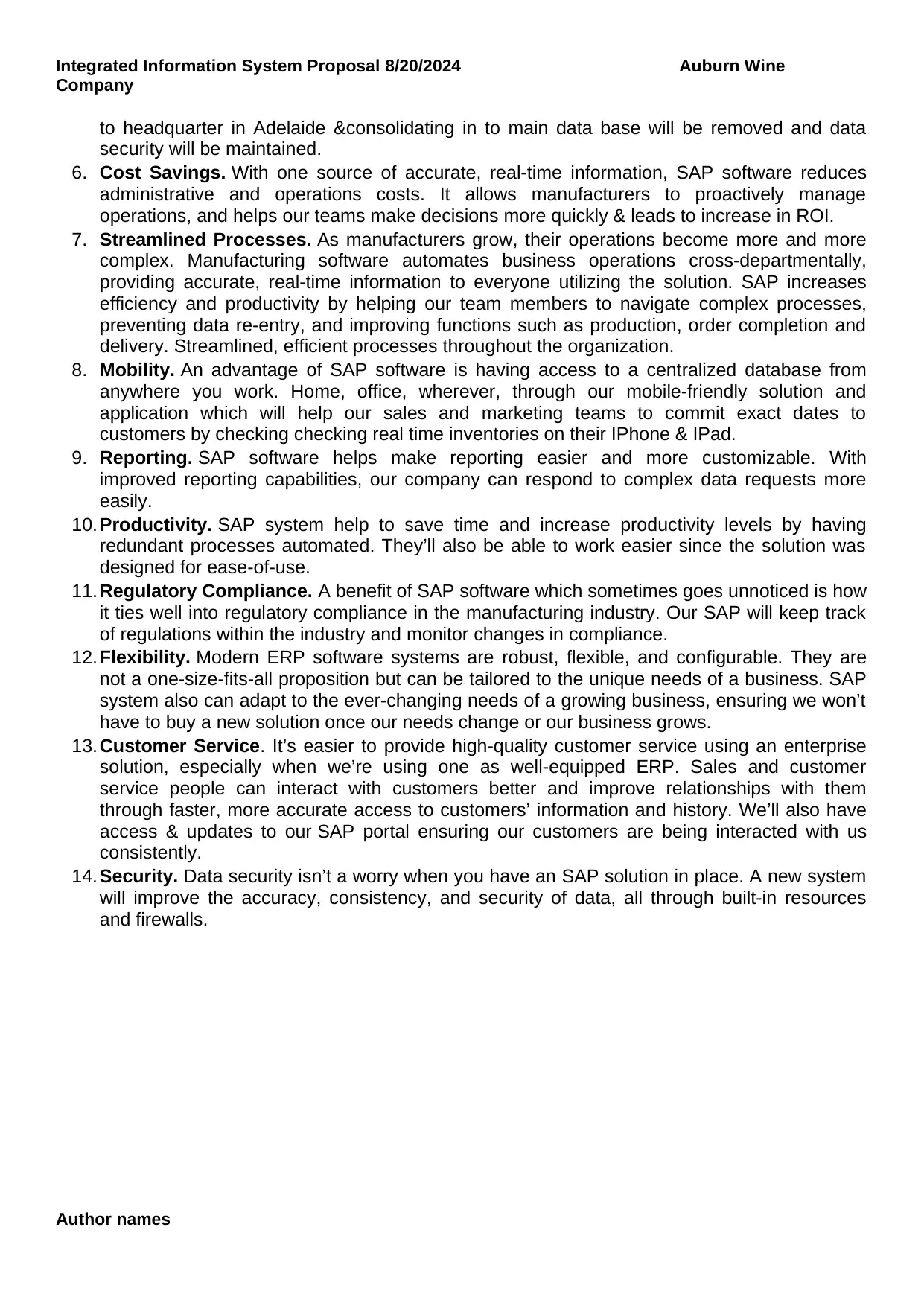
Integrated Information System Proposal 8/20/2024 Auburn Wine
Company
to headquarter in Adelaide &consolidating in to main data base will be removed and data
security will be maintained.
6. Cost Savings. With one source of accurate, real-time information, SAP software reduces
administrative and operations costs. It allows manufacturers to proactively manage
operations, and helps our teams make decisions more quickly & leads to increase in ROI.
7. Streamlined Processes. As manufacturers grow, their operations become more and more
complex. Manufacturing software automates business operations cross-departmentally,
providing accurate, real-time information to everyone utilizing the solution. SAP increases
efficiency and productivity by helping our team members to navigate complex processes,
preventing data re-entry, and improving functions such as production, order completion and
delivery. Streamlined, efficient processes throughout the organization.
8. Mobility. An advantage of SAP software is having access to a centralized database from
anywhere you work. Home, office, wherever, through our mobile-friendly solution and
application which will help our sales and marketing teams to commit exact dates to
customers by checking checking real time inventories on their IPhone & IPad.
9. Reporting. SAP software helps make reporting easier and more customizable. With
improved reporting capabilities, our company can respond to complex data requests more
easily.
10. Productivity. SAP system help to save time and increase productivity levels by having
redundant processes automated. They’ll also be able to work easier since the solution was
designed for ease-of-use.
11. Regulatory Compliance. A benefit of SAP software which sometimes goes unnoticed is how
it ties well into regulatory compliance in the manufacturing industry. Our SAP will keep track
of regulations within the industry and monitor changes in compliance.
12. Flexibility. Modern ERP software systems are robust, flexible, and configurable. They are
not a one-size-fits-all proposition but can be tailored to the unique needs of a business. SAP
system also can adapt to the ever-changing needs of a growing business, ensuring we won’t
have to buy a new solution once our needs change or our business grows.
13. Customer Service. It’s easier to provide high-quality customer service using an enterprise
solution, especially when we’re using one as well-equipped ERP. Sales and customer
service people can interact with customers better and improve relationships with them
through faster, more accurate access to customers’ information and history. We’ll also have
access & updates to our SAP portal ensuring our customers are being interacted with us
consistently.
14. Security. Data security isn’t a worry when you have an SAP solution in place. A new system
will improve the accuracy, consistency, and security of data, all through built-in resources
and firewalls.
Author names
Company
to headquarter in Adelaide &consolidating in to main data base will be removed and data
security will be maintained.
6. Cost Savings. With one source of accurate, real-time information, SAP software reduces
administrative and operations costs. It allows manufacturers to proactively manage
operations, and helps our teams make decisions more quickly & leads to increase in ROI.
7. Streamlined Processes. As manufacturers grow, their operations become more and more
complex. Manufacturing software automates business operations cross-departmentally,
providing accurate, real-time information to everyone utilizing the solution. SAP increases
efficiency and productivity by helping our team members to navigate complex processes,
preventing data re-entry, and improving functions such as production, order completion and
delivery. Streamlined, efficient processes throughout the organization.
8. Mobility. An advantage of SAP software is having access to a centralized database from
anywhere you work. Home, office, wherever, through our mobile-friendly solution and
application which will help our sales and marketing teams to commit exact dates to
customers by checking checking real time inventories on their IPhone & IPad.
9. Reporting. SAP software helps make reporting easier and more customizable. With
improved reporting capabilities, our company can respond to complex data requests more
easily.
10. Productivity. SAP system help to save time and increase productivity levels by having
redundant processes automated. They’ll also be able to work easier since the solution was
designed for ease-of-use.
11. Regulatory Compliance. A benefit of SAP software which sometimes goes unnoticed is how
it ties well into regulatory compliance in the manufacturing industry. Our SAP will keep track
of regulations within the industry and monitor changes in compliance.
12. Flexibility. Modern ERP software systems are robust, flexible, and configurable. They are
not a one-size-fits-all proposition but can be tailored to the unique needs of a business. SAP
system also can adapt to the ever-changing needs of a growing business, ensuring we won’t
have to buy a new solution once our needs change or our business grows.
13. Customer Service. It’s easier to provide high-quality customer service using an enterprise
solution, especially when we’re using one as well-equipped ERP. Sales and customer
service people can interact with customers better and improve relationships with them
through faster, more accurate access to customers’ information and history. We’ll also have
access & updates to our SAP portal ensuring our customers are being interacted with us
consistently.
14. Security. Data security isn’t a worry when you have an SAP solution in place. A new system
will improve the accuracy, consistency, and security of data, all through built-in resources
and firewalls.
Author names
Paraphrase This Document
Need a fresh take? Get an instant paraphrase of this document with our AI Paraphraser
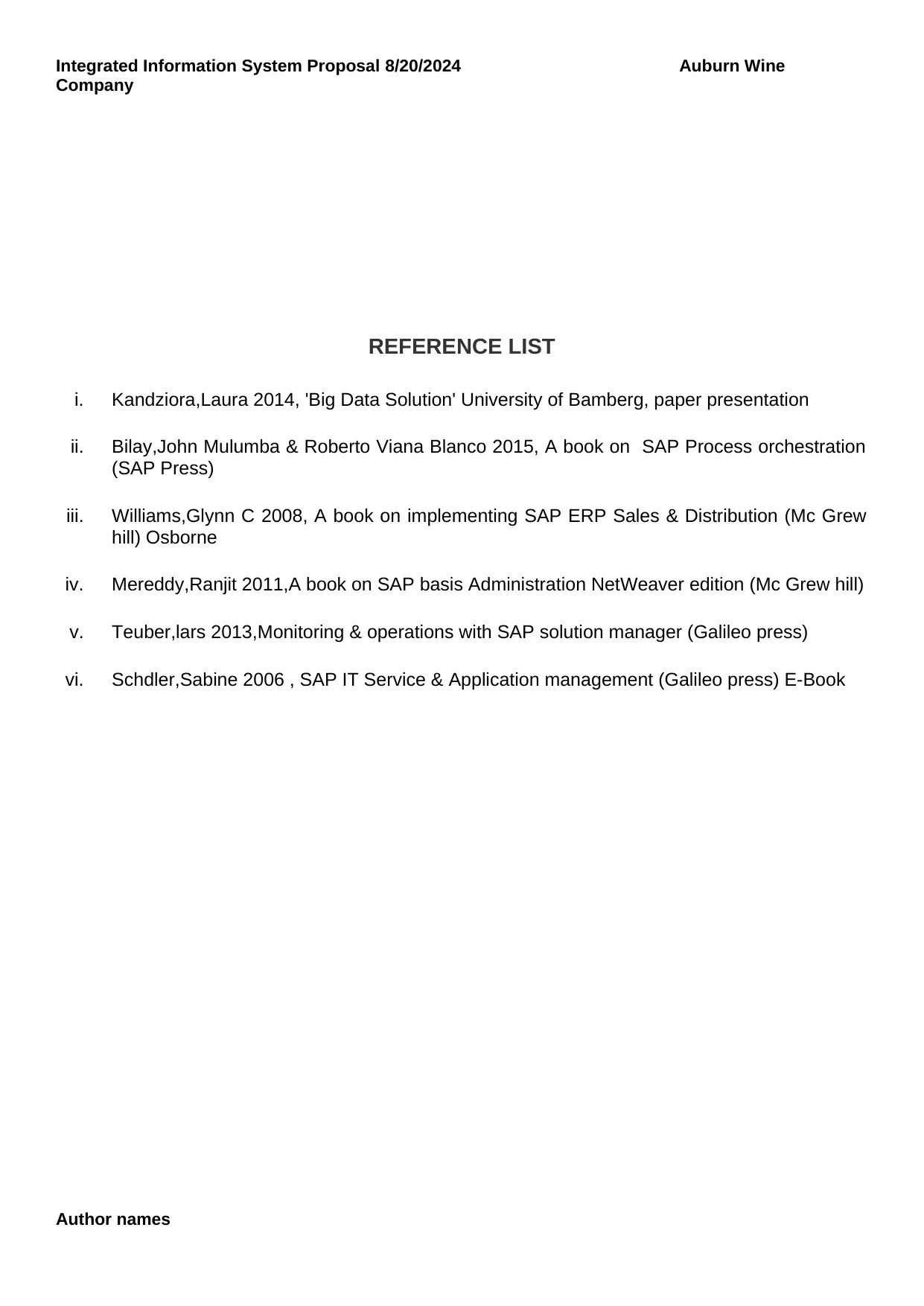
Integrated Information System Proposal 8/20/2024 Auburn Wine
Company
REFERENCE LIST
i. Kandziora,Laura 2014, 'Big Data Solution' University of Bamberg, paper presentation
ii. Bilay,John Mulumba & Roberto Viana Blanco 2015, A book on SAP Process orchestration
(SAP Press)
iii. Williams,Glynn C 2008, A book on implementing SAP ERP Sales & Distribution (Mc Grew
hill) Osborne
iv. Mereddy,Ranjit 2011,A book on SAP basis Administration NetWeaver edition (Mc Grew hill)
v. Teuber,lars 2013,Monitoring & operations with SAP solution manager (Galileo press)
vi. Schdler,Sabine 2006 , SAP IT Service & Application management (Galileo press) E-Book
Author names
Company
REFERENCE LIST
i. Kandziora,Laura 2014, 'Big Data Solution' University of Bamberg, paper presentation
ii. Bilay,John Mulumba & Roberto Viana Blanco 2015, A book on SAP Process orchestration
(SAP Press)
iii. Williams,Glynn C 2008, A book on implementing SAP ERP Sales & Distribution (Mc Grew
hill) Osborne
iv. Mereddy,Ranjit 2011,A book on SAP basis Administration NetWeaver edition (Mc Grew hill)
v. Teuber,lars 2013,Monitoring & operations with SAP solution manager (Galileo press)
vi. Schdler,Sabine 2006 , SAP IT Service & Application management (Galileo press) E-Book
Author names
1 out of 11
Your All-in-One AI-Powered Toolkit for Academic Success.
+13062052269
info@desklib.com
Available 24*7 on WhatsApp / Email
![[object Object]](/_next/static/media/star-bottom.7253800d.svg)
Unlock your academic potential
Copyright © 2020–2025 A2Z Services. All Rights Reserved. Developed and managed by ZUCOL.

